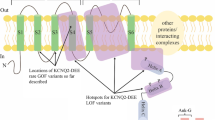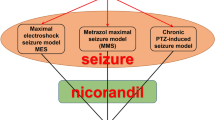Abstract
Purpose
KCNQ2/3 channels play an important role in controlling neuronal excitability. Agents that decrease KCNQ2/3 current amplitudes are proconvulsant, whereas KCNQ2/3 current enhancers are anticonvulsant. Levobupivacaine is able to block the KCNQ2/3 channels and enhance neuronal excitation, whereas retigabine is able to reopen the channels and thus reduce overexcitation of neurons. In this study, we aimed to determine if retigabine is able to abolish local-anesthetic-induced seizures.
Methods
Twenty New Zealand rabbits were randomly divided into two groups of ten. Levobupivacaine (0.5 %) was infused into conscious rabbits via the marginal ear vein at 8 ml/kg/h until the rabbits seized, and 5 mg/kg of retigabine were injected intravenously to terminate the seizure. The corresponding volume of saline was used as a control. The behavior of and the electroencephalogram (EEG) for each rabbit were continually monitored. Before levobupivacaine infusion, the rabbits were placed in a prostrate position calmly on the experimental platform, and the EEG pattern exhibited β waves. Intravenous levobupivacaine induced a typical EEG seizure characterized by multiple spike and slow wave complexes. The EEG changes were accompanied by behavioral convulsions which were characterized by clonic activity and opisthotonus.
Results
Retigabine effectively terminated the electrographic and behavioral seizures. After receiving 5 mg/kg of retigabine, the animals became drowsy, and the EEG changed to δ waves.
Conclusions
We propose that KCNQ2/3 channels play an important role in levobupivacaine-induced central nervous system toxicity, and a KCNQ2/3 channel activator may be used to treat levobupivacaine-induced convulsions.




Similar content being viewed by others
References
De Jong RH, Robles R, Corbin RW. Central actions of lidocaine synaptic transmission. Anesthesiology. 1969;30:19–23.
Huffman RD, Yim GK. Effects of diphenylaminoethanol and lidocaine on central inhibition. Int J Neuropharmacol. 1969;8:217–25.
Tanaka K, Yamasaki M. Blocking of cortical inhibitory synapses by intravenous lidocaine. Nature. 1966;209:207–8.
Valenzuela C, Moreno C, de la Cruz A, Macías Á, Prieto Á, González T. Stereoselective interactions between local anesthetics and ion channels. Chirality. 2012;24:944–50.
Punke MA, Friederich P. Retigabine stimulates human KCNQ2/Q3 channels in the presence of bupivacaine. Anesthesiology. 2004;101:430–8.
Santos AC, Arthur GR, Wlody D, De Armas P, Morishima HO, Finster M. Comparative systemic toxicity of ropivacaine and bupivacaine in nonpregnant and pregnant ewes. Anesthesiology. 1995;82:734–40.
Santos AC, DeArmas PI. Systemic toxicity of levobupivacaine, bupivacaine, and ropivacaine during continuous intravenous infusion to nonpregnant and pregnant ewes. Anesthesiology. 2001;95:1256–64.
Dillane D, Finucane BT. Local anesthetic systemic toxicity. Can J Anaesth. 2010;57:368–80.
Heavner JE. Local anesthetics. Curr Opinion Anaesthesiol. 2007;20:336–42.
Kindler CH, Yost CS. Two-pore domain potassium channels: new sites of local anesthetic action and toxicity. Reg Anesth Pain Med. 2005;30:260–74.
Saper CB, Chou TC, Scammell TE. The sleep switch: hypothalamic control of sleep and wakefulness. Trends Neurosci. 2001;24:726–31.
Gunthorpe MJ, Large CH, Sankar R. The mechanism of action of retigabine (ezogabine), a first-in-class K+ channel opener for the treatment of epilepsy. Epilepsia. 2012;53:412–24.
de La Coussaye JE, Eledjam JJ, Peray P, Bruelle P, Lefrant JY, Bassoul B, Desch G, Gagnol JP, Sassine A. Lemakalim, a potassium channel agonist, reverses electrophysiological impairments induced by a large dose of bupivacaine in anaesthetized dogs. Br J Anaesth. 1993;71:534–9.
Acknowledgments
We would like to thank Chen Xu from the EEG Center for her help in EEG examinations. We would also like to thank Zhenshan Zeng and Tao Li from the Center for Animal Experiment of the Third Hospital of Hebei Medical University for their assistance with the study. This work was supported by The Science & Technology Supporting Program of Hebei Province (grant no: 092061112D).
Author information
Authors and Affiliations
Corresponding author
Ethics declarations
Conflict of interest
None declared.
Presentation
None declared.
About this article
Cite this article
Cheng, Y., Li, H., Li, J. et al. Effectiveness of retigabine against levobupivacaine-induced central nervous system toxicity: a prospective, randomized animal study. J Anesth 30, 109–115 (2016). https://doi.org/10.1007/s00540-015-2069-x
Received:
Accepted:
Published:
Issue Date:
DOI: https://doi.org/10.1007/s00540-015-2069-x




